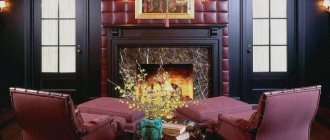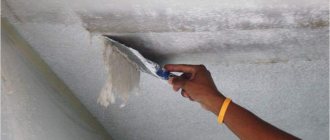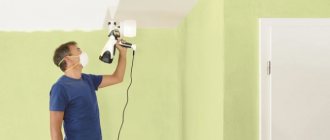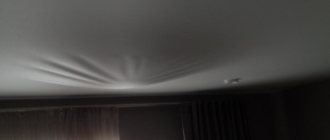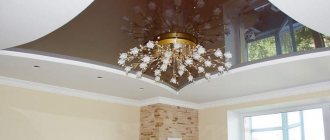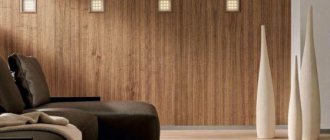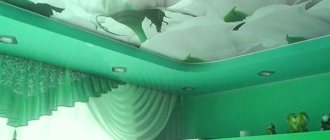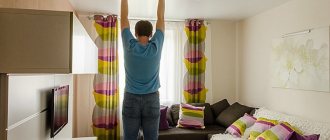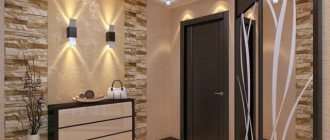Home / Ceiling design / Design solutions / What materials are relief ceilings made from?
An ordinary smooth ceiling looks very attractive, but you always want to somehow diversify the interior. This can be done by assembling a relief ceiling. Such surfaces can be made from various materials and all the main types of such finishes will be discussed in this material.
Pros and cons of finishing the ceiling
Advantages and disadvantages of textured ceilings.
| pros | Minuses |
| Due to their unusual texture, such canvases allow you to change the proportions of a room, hide its shortcomings and create unusual visual effects. | They have a fairly high price. |
| They have a wide range of colors, so you can choose the most suitable option that will match the rest of the decor. | |
| They imitate various materials very realistically. |
What is the difference between plaster and putty?
Before we move on to the process of creating decorative plaster from ordinary putty, let's understand these two concepts. In general, plaster is usually called a building mixture that is intended for leveling walls. Putty is also commonly called a building mixture for leveling walls, but, unlike ordinary plaster, we are talking about small errors.
What is the difference between putty and plaster?
What is the difference?
- Grinding If we carefully study the composition of both building materials, we will see that the putty uses substances of much smaller fractions, this makes it possible to create a thin coating.
- Price. There will also be a difference in the price of these two materials, which is due to the lower consumption of putty compared to plaster. Coarse filler costs much less for manufacturers.
- Strength. Plaster will be much stronger than putty. That is why it is often used to decorate external walls. If we recall the composition of concrete, we know that crushed stone is added to the composition to impart strength. So it is here. The larger the fraction of substances included in the mixture, the stronger and more durable the material itself will be.
- Compound. Plaster is mainly made from a cement-sand mixture with various additives. It can be clay-lime, clay-cement, gypsum and, less commonly, clay-cement composition. To produce putty, manufacturers use cement with sand, to which various plasticizers are added.
Starting plaster with coarse dispersion
Facade putty
In order to understand the scope of use and performance properties of various types of plaster and putty, let's take a closer look at the composition and types of these two materials.
Mirror
They create very interesting optical illusions and visual effects in space. Glossy film enlarges the room and raises the height of the ceiling.
The photo shows a kitchen-living room with a textured mirror stretch fabric in purple.
Positive and negative aspects when working with the ceiling
The advantages of this decorative material when working with the ceiling include the following points:
- Can hide small defects and unevenness in the ceiling.
- The coating is durable and environmentally friendly.
- When applied correctly, plaster lasts for decades and does not crumble.
- Despite the awkward position, applying the material is no more difficult than gluing wallpaper.
- Decorative plaster can be applied not only to an already plastered surface, but also to “bare” concrete slabs and other surfaces.
Finishing the ceiling with decorative plaster also has some disadvantages:
- Despite the simplicity of the work, you won’t be able to make a high-quality coating yourself the first time (except perhaps the most primitive one).
- It is necessary to know exactly the composition of the material so as not to make mistakes due to which it will begin to crack or crumble.
- When working with fine-textured plaster, the ceiling surface must be perfectly smooth.
Mother of pearl
They shimmer with a soft pearl sheen, which gives the entire interior a special luxury and elegance.
Textures of suspended ceilings
There are three types of standard invoices:
- Matte is a classic stretch fabric, the distinctive feature of which is the absence of relief images on the surface, smoothness and evenness. The main function of a matte canvas is to emphasize the beauty of the ceiling covering, highlighting the pattern or depth of color.
- The satin texture makes the ceilings expressive and attractive. Higher light reflection abilities than the first option saturate the colors of the coating. This occurs due to the shifting shades under the influence of artificial or natural light.
- Glossy has high reflective abilities. This property allows you to visually expand the room, make it voluminous and bright.
Each texture is created on a specific type of material. For example, gloss is done only on PVC film, but a matte structure can be used for both fabric and film coatings. Satin surfaces should be classified as a separate category, since they are based on fabric fabric impregnated with polyvinyl chloride.
Unusual textures are of particular interest. In this case, the basis of the ceiling is an original PVC film with an intricate relief applied to the surface or painted using special paints to imitate marble, silk, suede, or mother-of-pearl. At the same time, the front part of the canvas is not smooth, but textured, with an imitation of a pattern, or having a rough surface.
The advantages of a stretch ceiling with a textured finish are similar to the advantages of conventional film canvases. These are durability, reliability, ease of use, no need for special care, and moisture resistance.
What other textures can there be on ceilings?
- Metallic is a luxurious and original ceiling texture that gives the room severity and brutality. Such a design will best fit into the style of hi-tech, minimalism and other modern trends.
- Silk on ceilings should be used in bedrooms and children's rooms. The muted shine of the surface will make the ceiling soft and cozy. By varying the color shades you can create a romantic atmosphere in the room.
On a note! Do not install dark silk fabrics; they visually make the ceilings heavier. But golden structural surfaces are ideal for decorating a bedroom in a classic style.
- Exotic marble will fit organically into a living room or large hall. The material looks so natural that in appearance it resembles cladding with marble slabs.
- Pearls on the ceiling will make the room soft, and its light shades will visually give it additional volume.
- Mother-of-pearl qualitatively imitates pearls on ceilings, giving the room a certain luxury and nobility.
Under the tree
Such textured tension panels are an integral part of modern design projects. They bring coziness to the premises and create a warm and comfortable atmosphere in it.
Ceiling models with imitation of boards, logs or saw cuts always look very stylish and expensive. These coatings look realistic and are practically no different from natural wooden products.
The photo shows a wood textured stretch ceiling.
DIY finishing. Some recommendations
When you decide to decorate the ceiling with decorative plaster, do not forget about the time required for the work.
If you have little time to carry out repairs, it is better to immediately choose a different type of finish. This is due to the long drying time of the plaster - this process takes at least one week. Only after the coating has completely dried is it allowed to coat it with paint or varnish.
If you don't like the default white color of the stucco, you can change it very easily. To do this, during the process of preparing the mixture and mixing it, you need to add the selected dye to the container. But in order not to make a mistake with the color intensity, you first need to cover a small area of the ceiling, checking the result.
The popularity of decorative plaster is completely justified. This type of ceiling decoration makes it easy to transform it into a real work of art. Decorative plaster on the ceiling, a photo of which can be seen on the website, decorates various rooms, from private living rooms to galleries and concert halls. In addition, popular construction magazines do not miss the opportunity to post on their pages images of interesting solutions that were brought to life by professional designers.
Imitation of Venetian plaster
Matte or glossy canvases imitating decorative Venetian plaster form a subtle, sophisticated and elegant design.
This textured ceiling has an expressive appearance and is quite a fashionable trend that goes well with many style solutions.
The photo shows a textured stretch fabric with imitation of Venetian plaster in the living room.
Types of plaster compositions for ceiling decoration
- flock;
- textured;
- Venetian;
- structural.
Textured
Textured plaster for the ceiling is produced with fractions of different sizes (0.5-5 mm). The material is easy to apply, lays flat, and has a uniform structure. After drying, the surface acquires texture. When working with a variety of plaster, different application and processing techniques can be used.
- binder;
- filler (stone chips, fine sand);
- modifying additives (antiseptics, plasticizers);
- decorative elements (pearl particles, dyes, metal chips).
Structural
Structural plaster is characterized by plasticity, high grain size, and is produced in white color. You can add colors to the composition for tinting. The material is used to work on different types of surfaces; the patterned-relief texture remains after drying.
- fibers;
- shell fragments;
- artificial granules;
- different fractions of river sand;
- metal shavings.
The material is recommended to be used for finishing walls near sockets, creating borders, and treating part of the ceiling surface. The composition cannot be used in compact spaces.
Flock
A variety of plaster allows you to create the effect of liquid wallpaper and implement an aesthetic design solution. Using a flock composition, you can create original designs, combine several shades on the surface, and give the effect of a silk or mother-of-pearl texture. The coating is smooth, without joints. The surface can be smooth or with the effects of abrasions and artificial aging.
Features of Venetian plaster
Venetian decorative plaster is used in classical, baroque, rococo, modern, etc. styles. The finishing is distinguished by its aesthetics and elegance of execution. To create Venetian plaster, super-fine textured mixtures with the addition of stone flour are used. The execution technique involves sequential application of thin layers to the surface. The base must first be carefully leveled. The material is expensive; applying Venetian coating requires a lot of time.
Under concrete
This ceiling covering looks like a real flat and smooth concrete surface. This laconic design is not only aesthetically pleasing, but also practical.
The photo shows a living room with a concrete textured stretch ceiling.
Stucco on the ceiling
Antique or Gothic interior style involves the inclusion of stucco elements in the design of the room.
Such decorative products are represented by many variations, the main of which are:
- moldings - used to disguise joints between walls and ceilings. A smooth molding or a relief element can complement a classic interior, Provence or high-tech trends;
- rosettes are an equally popular type of stucco ceiling design, used for decorative finishing of the chandelier mounting area;
- cornices, borders, flower arrangements will also help diversify the interior.
All these elements can be made not only from traditional gypsum, but also polyurethane, which has better properties and physical characteristics:
- long service life, increased strength;
- moisture resistance;
- ease;
- plasticity and flexibility;
- a wide range of.
Liquid nails are used to finish polyurethane stucco.
Metallic
It will shimmer with a characteristic silver sheen and change color saturation due to the intensity of lighting.
Gold
This decorative gold embossed ceiling covering features a unique patina surface and stunning shimmer. It is perfect for both classic and modern interior solutions.
The photo shows a bedroom with a stretch textured ceiling with imitation gold.
Work principles
The installation of decorative plaster is carried out in several stages:
- surface preparation;
- preparing the solution;
- applying the mass;
- pattern formation;
- painting, waxing, glazing.
The application technique can include from 1 to 3-4 layers with a total thickness of up to 10 mm. The interval between operations ranges from 15 minutes to 6-8 hours.
It is recommended to work together - one person applies the mixture, the other forms the pattern. If there is only one master, the plaster is divided into sections of 1-1.5 sq.m.
The surface texture depends on the type and size of the filler:
finely ground grains form a fairly smooth structure, the relief on the wall is set by the master; Large inclusions themselves create a pattern; it is important to correctly apply the material to the surface.
Before painting, the coating must be dried for up to 24 hours. Coloring can be done in several stages. Additional processing to obtain an artificially aged surface, patina or pearlescent sheen will give the finish an even more attractive and impressive look.
Marble
Marble texture model is no different from real stone. The ceiling surface with such cladding looks very natural and allows you to create a luxurious, pompous and rich interior.
The photo shows a textured stretch fabric with imitation marble in the living room.
Advantages and disadvantages of textured paints
Compared to simple paint bases, textured paints have their undeniable advantages:
- painting work will not require a lot of time;
- a layer of paint will make the base of the rough ceiling even and will hide chips and cracks;
- surfaces coated with textured paint are not afraid of mechanical influences, they can be washed and repaired;
- the material is inexpensive and environmentally friendly;
- The color shades are amazingly diverse.
The main disadvantage of this finishing method is the high consumption of material. One square meter of surface will require more than a kilogram of paint.
Types of textured paints
According to the aesthetic effect, textured paints are divided into:
- classic;
- multicolor, characterized by a variety of shades or giving a luminescent glow;
- paints with a decorative effect inherent in their basis. In turn, they are also divided into separate types:
- mosaic (granite). Using original paints of this type, it will be possible to recreate an imitation of decorative plaster, natural stone or other interesting decoration on the ceiling;
- plastic masses. Their viscous texture allows you to create deep relief surfaces, under which you can hide all the imperfections of the rough ceiling.
Textured ceiling painting technology
All types of paints are universal in their technical characteristics and methods of application. Therefore, with the help of such means it will be possible to radically change the interior of the room by decorating any surface - wood, plaster, cement.
Painting the ceiling includes several successive stages, the main of which is preparing the surface for painting. At this stage, the previous finish is cleaned off, the ceiling surface is leveled and puttied.
Next, the ceiling is painted:
- the right direction is from the corner to the center of the room;
- movements should be smooth to avoid smudges;
- each subsequent layer is applied parallel to the previous one.
Leather
Models imitating leather especially stand out in the interior and create the feeling as if the ceiling surface is actually covered with natural products.
Reptiles (snakes, crocodiles)
They have an appearance as close as possible to the original. Such textured canvases look completely unique and give the entire interior a special personality.
Giraffe
Ceiling products with such a pattern add color, uniqueness and effectiveness to the room, and add a touch of exoticism to it.
Tools and materials
If all the work will be done by yourself, you will need:
- ladder;
- roller with a pattern for painting the ceiling;
- trays for paint and primer;
- putty (starting and finishing);
- primer (universal or deep penetration);
- set of spatulas;
- basin for water;
- rags, sponges and brushes for washing the ceiling;
- rollers and brushes;
- acrylic paint;
- paint container;
- drill with a nozzle for stirring the coloring agent;
- masking tape;
- polyethylene film;
- sandpaper or sander;
- spray;
- protective clothing and glasses.
Decorative natural textures
They allow you to give the ceiling decoration an even more unique appearance, add more coziness to the room and even visually adjust its proportions.
Sky and clouds
They transform the ceiling plane into a real art object. This design makes the room spacious and airy and creates a wonderful, enchanting and amazing atmosphere in it.
The photo shows a living room and a textured stretch ceiling depicting a sky with clouds.
Grass and greenery
Fills the space with warmth and a special positive mood. Grass and greenery are quite an interesting design technique that creates a deep and expressive interior.
Water
Water drops frozen on the ceiling attract attention and give the room additional tenderness and lightness.
The photo shows a bathroom with a stretched textured fabric simulating water drops.
Bamboo
The exoticism of bamboo will add brightness and expressiveness to the room and, thanks to its natural appearance, will fill the atmosphere with freshness.
Galaxy
Rich galactic designs in dark blue and black shades look especially delightful. They visually increase the dimensions of the room and give it bottomless spatial depth.
The photo shows a textured stretch fabric with an image of a galaxy in a nursery.
Plaster or paint
Another common way to give a plane a relief. There are ready-made plaster mixtures on sale that just need to be diluted with water and they are ready for use. They are called “modeling plasters”. They are very easy to use, and the pattern you create depends only on your imagination.
All that is required to create a beautiful surface is imagination and a few available tools. At the same time, the tools are not limited to the usual devices, but can even include a simple crumpled film, a dishwashing sponge or paint brushes with stiff bristles.
Such homemade devices are especially suitable in cases where relief paint is used to decorate the ceiling. Its peculiarity is that after application it forms a very plastic surface that can be modeled at will. It is also applied quite unusually - using a spatula. You can also use traditional rollers, but a spatula allows you to apply a thicker layer and immediately give it the desired relief.
To give the plane the desired pattern or model some small volume on it, you will need a spatula or embossed construction rollers, which are perfect for decorating such an unusual ceiling. Instead, you can use a crumpled film or a sponge, which is applied to the paint surface that has not yet dried, forming an intricate pattern of prints. The drawing can be applied with anything at all, as long as the resulting result meets expectations.
Fabric imitation
Various fabric imitations or silk-screen printing can add harmony and style to any interior.
Suede
Perfectly copies the features and characteristics of suede fabric. It has a soft velvety surface, which creates a warm and very cozy atmosphere in the room.
Brocade
Stretch fabrics with a brocade texture look no different from this expensive fabric. White products or models with a shimmer of mother-of-pearl can organically fit into almost any interior.
This surface looks very original and elegant, and thanks to its special iridescent reflection, it adds elegance and charm to the environment.
Silk
Imitation of natural silk looks noble and brings shine, softness and lightness to the interior.
The photo shows a textured stretch ceiling with imitation silk fabric.
Advantages
Soundproofing the ceiling in an apartment with a suspended ceiling
The advantages of textured ceilings are basically similar to the advantages of conventional stretch ceilings. Long service life, quick installation, ease of use, moisture, heat and sound insulation.
The textured stretch ceiling in the interior looks incredibly aesthetically pleasing. For the interior in children's rooms, a suspended ceiling made of silk is usually chosen. Not bright shine gives a feeling of comfort and coziness.
Using a pastel color palette you can achieve peace and romance; this option will be an excellent bedroom decoration.
Another advantage is the size of the textured tension surface. It is known that standard PVC film has a maximum width of three meters. This is certainly enough for a standard room. But what if your room is a little wider? Textured ceilings can easily cope with this complexity. Firstly, such a surface is much wider. Secondly, the seam when gluing different or identical textures is practically invisible.
To decorate the ceiling with different types of textures, you need to understand how to combine them correctly. For example, matte and glossy finishes cannot be used together. There are a number of reasons for this. Firstly, this combination will narrow the space of the room. Secondly, matte fabric absorbs light, while the metal coating, on the contrary, reflects it. As a result, few light sources simply dissolve in space. Thus, leaving certain areas of the room in complete darkness. Matte fabrics are best combined with silk. Silk material will form the basis of the picture, and matte material will frame the edges of the “picture”.
Original textures of paintings
With the help of original textured products, you can create unusual effects in the room.
Chameleon
This unique ceiling design has a very interesting texture, which can change its shade depending on the viewing angle and type of lighting.
Mosaic
It has an expressive, beautiful structural pattern and is distinguished by a slight shine. Small polyhedrons in different colors and shades go well with various decorative elements.
Preparing the ceiling for painting
At home, the easiest way to make a textured ceiling is to use a relief roller. Painting the ceiling with a textured roller is done after preparing the base.
The preparatory work is as follows:
- First, the ceiling is cleaned of old finishing. If there was previously a chalky whitewash on the surface, it is washed off with a soap solution and then the ceiling is washed with clean water. Lime whitewash is moistened with water and cleaned off with a spatula after the layer has been soaked. Moisture-resistant paints are removed with special removers, and non-moisture-resistant paints are washed off with water. If there are foam tiles on the ceiling, then remove them with a spatula with remaining glue. The wallpaper finish is also moistened with water, and after soaking it is cleaned off with a spatula.
- After removing the old finish, wash the ceiling surface well and allow it to dry.
- Now they begin to level and seal defects. Significant holes, crevices, cracks and chips are cleaned of dust and primed. After this, they are filled with plaster mortar or starting putty. Minor unevenness can be removed with a finishing putty solution.
- After the solution has dried, the surface is sanded to get rid of significant protrusions and irregularities, and cleaned of dust using a rag or vacuum cleaner.
- Then the surface must be treated with a primer. It is recommended to use a deep penetration primer or a universal solution based on the same components as the coloring agent. To treat the ceiling in a room with high humidity, it is recommended to use primers with antiseptic components to prevent mold from appearing on the ceiling in the future. The primer is applied with a roller in two layers. Each layer must dry completely before applying the next one.
Recommendations for choosing texture
Some basic tips for choosing wisely:
- Mirrored textured models are perfect for small rooms, as they allow you to visually expand the space.
- It is not advisable to use too colorful textures in small rooms; this can disrupt the overall perception of the interior and make it uncomfortable.
Application of structural plaster
Most often, such material is applied with a spatula or stainless steel trowel, and then smoothed with a plastic trowel. This will help distribute the granules evenly over the surface. If you decide to give the ceiling a grooved relief, proceed as follows:
- pick up the mass on a wide spatula, transfer it to the base and immediately stretch it;
- roll the ceiling with a smooth roller and leave for 12 hours;
- rub the ceiling with a float, pressing it tightly and moving it in different directions;
- use a narrow spatula to cut off the elements that protrude too much, then apply a primer and paint the ceiling.
Applying textured plaster
After applying the plaster, roll it over the surface with a figured roller or create a pattern with a brush. It is important to do this before the material hardens, otherwise you will not be able to get a pattern. A day later, the ceiling is primed and painted.
Application of Venetian plaster
The Venetian is applied in several layers (up to 12 or more) with asymmetrical and wide strokes. First, use a spatula, and then level the strokes with a special metal trowel (until the coating dries). Each layer is dried and the work is repeated. As a rule, the layers are very thin and the total thickness of the finish does not exceed 5 mm. Afterwards, the ceiling is covered with wax or varnish to give it the effect of depth and volume.
Working with Venetian plaster
Sgraffito drawing
This technique is a special way of processing a solution that has not completely hardened. The pattern is created on the ceiling in any of two ways - deepening (removing a layer of plaster) or filling (applying the composition using a stencil). Typically, the sgraffito technique is used to draw patterns, and not to completely process the ceiling. With its help, you can highlight the area of the chandelier, corners, and outline the perimeter.
Sgraffito technique
The popularity of using decorative plaster to decorate ceilings is quite justified. The material gives the room an aesthetic, original look, and is also easy to apply, and the variety of its types will satisfy the requirements of the most picky users.
